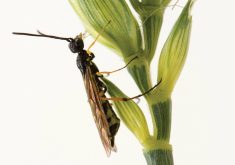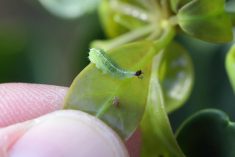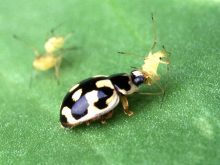Wondering what types of beneficial insects you have beetling around your fields? Try a ground trap.
“It’s nice to know that you’ve got some good guys in there that are eating the bad guys,” said Patty Reid, a research tech with Agriculture and Agri-Food Canada. There isn’t an economic threshold for beneficial insects such as ground beetles yet, said Reid. But trapping beneficials gives farmers a look-see, and could factor into a spray decision, she said.
Reid was part of the Canola Council of Canada’s CanoLAB in Vermilion’s Lakeland College this February. During the beneficial insect lab, people peered at beetles under microscopes, took a close look at other preserved beneficial insects and bugs, and even watched beetles feasting on cutworms. Experts were on hand to answer questions and show everyone what they were looking at.
Read Also

Claas brings 1000 Series SP forage harvesters to Canada
In mid-August, Claas unveiled its new line of Jaguar forage harvesters at an event in Visalia, California, deep in the heart of that state’s dairy region.
Reid encouraged people to pluck ground beetles from their liquid baths, using tweezers, and count them. She explained how to set ground traps to catch the beetles, and what farmers and agronomists could expect.
Ground traps will catch other insects as well, including pea leaf weevils and flies, she said. But ground beetles are the insects to focus on, Reid says. The beetles are voracious predators of insect pests.
“They eat eggs. They eat larvae. They parasitize larvae,” she said. They also eat adult insects, she added.
How to do it
Farmers can use a professional or home-made trap for catching ground beetles. The professional traps were developed by Dr. Bob Vernon of AAFC in Agasiz, B.C.
To set up and use the professional trap:
- Use a bulb planter to dig between the rows (Reid recommends a bulb planter because the trap is tapered). The hole needs to be deep enough so that the trap’s top is level with the soil surface, allowing the bugs can walk into it.
- Add plumbing anti-freeze to the small cup that fits inside the trap.
- Place the lid on the trap. The serrated lid will keep out mice, frogs, and salamanders.
- After a week, retrieve the cups. If you wait longer, the cups will stink.
- Dump the contents into a container. Reid recommends a flat Ziploc container.
- Sort through the insects in the trap and count the ground beetles
Farmers might have a hard time getting their hands on a professional trap right now. Curious producers can also use a yogurt container and pie plate to create their own traps. To place the trap, dig a hole between the rows, so the top sits flat with the soil surface. Dump the anti-freeze into the container, which acts as a pitfall. Put the pie plate over the container to prevent evaporation.
Sometimes the home-made traps have a one-inch gap between the cover and the pitfall container. Unfortunately, mice and salamanders can squeeze through that gap, fouling the trap, so be prepared.
In a follow up email, Dr. Jim Broatch, pest management specialist with AAFC, wrote that five to 10 traps could help farmers figure out the beetle population in that field.
Broatch says research has been published on how beneficial insects affect foliar pests such as aphids. Ground beetles research “could be the next phase in the understanding of pest management for use in an IPM program,” he writes.
For now, what’s a healthy number of beetles? Broatch said if the beetles have plenty of insects to eat and several crops to occupy, farmers could see high beetle numbers. Reid said they’ve found up to 53 melanarius ground beetles in one trap over a week during their field studies.
How many a farmer will see depends on the year, and whether they’ve sprayed. “The more the better,” said Reid.
Asked whether she had any other advice for farmers trapping beetles, she said: “Just have fun.”
















